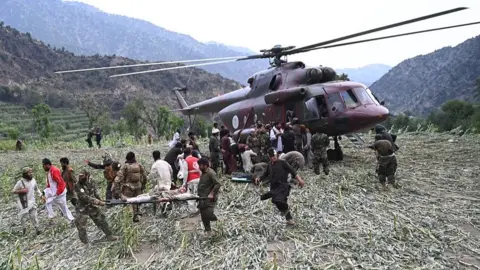New Aftershock Strikes Afghanistan Amidst Quake Aftermath
A fresh magnitude-5.2 aftershock has struck eastern Afghanistan - two days after a powerful quake in the same region killed more than 1,400 people and injured 3,000 others, according to the Taliban government.
Rescue efforts following Sunday’s magnitude-six quake have been complicated by landslides that have blocked roads, making land travel difficult. Helicopters have been deployed to aid the search for survivors in the ruins of remote villages, where many are feared trapped under the rubble.
The Taliban government - which is only recognised by Russia - has appealed for international help. The UN has released emergency funds, while the UK has pledged £1m ($1.3m) in aid.
Afghanistan is prone to earthquakes, but Sunday’s tremor was one of the strongest to hit in recent years. The aftershock on Tuesday came at 12:29 (07:59 GMT) with its epicentre 34km (21 miles) away from Jalalabad, the country’s fifth-largest city, according to the US Geological Survey (USGS). It was shallow, at only 10km deep.
A BBC reporter in the Sawkai district - one of the worst affected areas in the north-eastern Kunar province - said they felt a strong jolt. There are no reports of damage or new casualties.
Helicopters are being used to airlift survivors out of remote villages in Kunar province - where most of the deaths and injuries occurred. The terrain was so rough in one part of the Mazar valley that one helicopter failed to land after three attempts, one Taliban source said.
Survivor Bas Marjana, a resident there, recalled, We were all in deep, peaceful sleep when... a sudden tremor struck, and the world turned upside down. She said she was rescued from underneath the rubble of her home, but several other family members were buried. She stated eight of her grandchildren and her daughter-in-law were killed.
Aid agency Save the Children has sent medical teams to the Kunar province to treat and rescue people in remote areas, where it said thousands were in urgent need of food, water and shelter. One volunteer, identified only as Dr Shaheer, noted that some people had resorted to drinking river water.
The situation of children is severe. If they do not receive support, children in the earthquake-affected areas will face nutrition, health, and other challenges, he added. Médecins Sans Frontières (MSF) said its teams had reached two hospitals, one in the Nangarhar province and the other in the Laghman province.
Fazal Hadi, MSF deputy medical coordinator, stressed the humanitarian response needed to scale up urgently. The two hospitals were already working at full capacity before the earthquake. We saw many patients treated in the corridors and health workers in need of supplies, he added.
At Jalalabad’s Nangrahar Regional Hospital, earthquake survivor Nader Khan broke down as he recalled how he lost two sons and two daughters-in-law to the earthquake. Khan, who is in his 60s, said he managed to save two grandchildren but now doesn’t know their whereabouts.
Mir Zaman shared a chilling account of digging his dead children out of the rubble with a shovel and pickaxe. As the aftershocks continue to rattle the region, the humanitarian crisis only escalates.
The most recent earthquake hit Afghanistan when it is reeling under severe drought and what the UN calls an unprecedented crisis of hunger. The country has also experienced massive aid cuts this year, further reducing the support available to those affected.



















